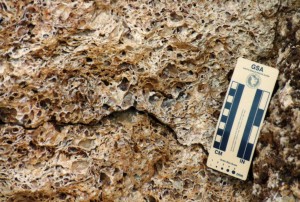Tiles come in a wide variety of materials. No matter what material is chosen, installation has these basic steps. One of the first requirements is a solid and firm base. A mastic or mud bed is spread on the firm base to hold the tile in place. The tiles are then laid on the mud to form the desired pattern. The mud is allowed to dry before a grout is spread to fill the spaces between the tiles. A sealer is applied to the entire area to prevent discoloration of the grout and the tile.
The above statements apply to all forms of tiles. Installing travertine follows the regular rules plus a few that are specific to a natural stone and a veined material.
One of the considerations when working with travertine tile is the veining of the stone. A commonly used method of shaping man-made tiles is by using a “score and snap device”. This method does not work with travertine. The natural travertine is porous, and may have those pores filled with a special mixture of cement and epoxy. The combination of the stone and filler gives the tile an irregular density that requires a power tool to cut the tile. The veins that run through the travertine add another complication for the installer. The veins are a natural “weakness” lines in the stone. Cuts can be made across the veins, but experience working with travertine will help guide a installer to prevent unwanted breaks both at the time of setting and later.
The tiles are cut from natural stone. The stone will vary from quarry to quarry and cutting results in some irregularities in the thickness and shape of the tiles. Most of the irregularities can be adjusted by the way the tile is laid. Again, an experienced tile setter will adjust the mud bed to compensate for variation in thickness, and can position the tiles to conceal the size differences.
Because the stone is a natural product and no two tiles will be the same, the coloration in the stone will vary a great deal. Some of the tiles will have many veins and others little or none. It is highly recommended that you open and inspect all the boxes of tiles to allow the installer and the homeowner to view the stone and lay out a pattern that is most pleasing. This will also allow the installer to select the best tiles to cut before the job is started. This could save time and money because fewer tiles are ruined. In many cases laying out the whole area will be well worth the time.
Most installers feel that sealing the tile is a must. Sealing the stone is a simple way to assure the tile will remain beautiful. Re-sealing the tile every few years is also recommended. The routine care and maintenance is best done with clear water.
Mild soaps can be used but harsh cleaners and acids should never be used. The calcium carbonate of the travertine will react with even weak acids and dissolve. This will cause the stone to etch and could cause significant and irreversible damage. If you are uncertain you can test any cleaner on a sample tile reserved for that purpose before you use anything on the installed tiles.
Related posts:
Introduction to Travertine Tiles
Unusual Occurrence of a Fossil in Travertine
